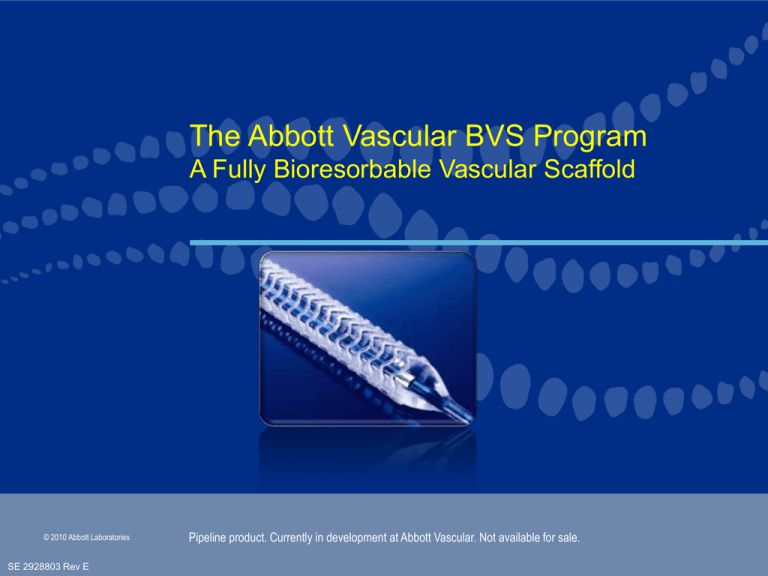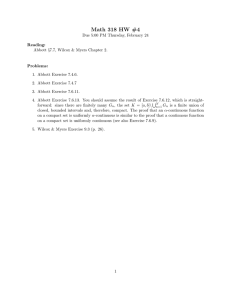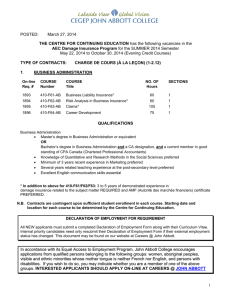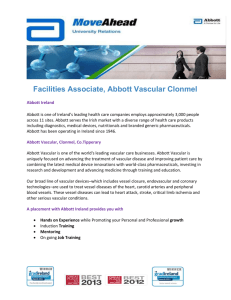File - Dr Richard Bogle
advertisement

The Abbott Vascular BVS Program A Fully Bioresorbable Vascular Scaffold © 2010 Abbott Laboratories SE 2928803 Rev E Pipeline product. Currently in development at Abbott Vascular. Not available for sale. Bioresorbable Scaffold – Rationale and Goals Rationale: Vessel scaffolding is only needed transiently* Goal: Revascularize the vessel like a metallic DES, then resorb naturally into the body. Potential benefits: • Restoration of natural physiologic vasomotor function in some patients • Elimination of chronic sources of vessel irritation and sources for chronic inflammation • Possibly avoid current challenges with leaving a metal implant behind • Potentially reduce the need for prolonged DAPT • No permanent implant to complicate future interventions and re-interventions, particularly in younger patients • Non-invasive imaging with MSCT or MRA without ‘blooming artifact’ *Serruys PW, et al., Circulation 1988; 77: 361. Serial study suggesting vessels stabilize 3-4 months following PTCA. © 2010 Abbott Laboratories SE 2928803 Rev E Pipeline product. Currently in development at Abbott Vascular. Not available for sale. Abbott Vascular Everolimus-Eluting Bioresorbable Vascular Scaffold Components ML VISION Delivery System • Seven generations of MULTI-LINK success • World-class deliverability Bioresorbable Scaffold • Polylactide (PLLA) • Naturally resorbed, fully metabolized Bioresorbable Coating • Polylactide (PDLLA) coating • Fully biodegradable All illustrations are artists’ renditions © 2010 Abbott Laboratories SE 2928803 Rev E Pipeline product. Currently in development at Abbott Vascular. Not available for sale. Everolimus • Similar dose density and release rate to XIENCE V Bioresorbable Polymer Everolimus/PDLLA Matrix Coating • Thin coating layer • Amorphous (non-crystalline) • 1:1 ratio of Everolimus/PLA matrix • Conformal Coating, 2-4 m thick Drug/polymer matrix Polymer backbone • Controlled drug release PLLA Scaffold • Highly crystalline • Provides device integrity • Processed for increased radial strength © 2010 Abbott Laboratories SE 2928803 Rev E Pipeline product. Currently in development at Abbott Vascular. Not available for sale. Polylactide Degradation by Hydrolysis • Primary mode of degradation is by hydrolysis of ester bonds • Water preferentially penetrates amorphous regions of the polymer matrix • Hydrolysis initially results in a loss of molecular weight, but not radial strength, as the strength comes from crystalline domains • Once crystalline domains are hydrolyzed, there is mass loss 1Pietrzak WS, et al. J. Craniofaxial Surg, 1997; 2: 92-96. Middleton JC, Tipton AJ, Biomaterials, 21 (2000) 2335-2346. © 2010 Abbott Laboratories SE 2928803 Rev E Pipeline product. Currently in development at Abbott Vascular. Not available for sale. Polylactide Degradation & Lactate Metabolism Strut Remnant C3H6O3 Lactic Acid Lactate Shuttle1 DIFFUSION Lactate serves as a carbohydrate fuel source for multiple metabolic pathways C3H6O3 Lactic Acid CH3CH(OH)COO- + H+ Lactate CH3CH(OH)COO- CH3COCOO- + H+ Lactate CH3COSCoA Pyruvate Acetyl-CoA Citrate Oxaloacetate Intracellular Mitochondrion H2O CO2 Malate Fumarate TCA (Krebs) Cycle Isocitrate Ketogluterate ATP Succinate 1. Philp, A., et.al. J. Exp. Biol. 2005; 208: 4561-4575. © 2010 Abbott Laboratories SE 2928803 Rev E Pipeline product. Currently in development at Abbott Vascular. Not available for sale. Succinyl-CoA Porcine Coronary Artery: Representative Photomicrographs (2x) BVS Cohort A 1 month 6 months 1 year 2 years 3 years 4 years 6 months 1 year 2 years 3 years 4 years CYPHER 1 month Photos taken by and on file at Abbott Vascular. © 2010 Abbott Laboratories SE 2928803 Rev E Tests performed by and data on file at Abbott Vascular. Pipeline product. Currently in development at Abbott Vascular. Not available for sale. Vascular Response to BVS at 2, 3 & 4 years: Arterial Integration and Accommodation • Mass loss data suggests 100% of material mass has been lost at 2 years Representative porcine coronary arteries, 2x objective 324 years years • The shape of struts is still apparent at 2 years, although the device is fully resorbed • No inflammation around the preexisting strut regions • 3 years: struts fully replaced by tissue • 4 years: sites10x of pre-existing struts are indiscernible Photos taken by and on file at Abbott Vascular. © 2010 Abbott Laboratories SE 2928803 Rev E Alcian Blue Stain: Proteoglycan Tests performed by and data on file at Abbott Vascular. Pipeline product. Currently in development at Abbott Vascular. Not available for sale. What is Required of a Fully Bioresorbable Scaffold to Fulfill the Desire for ‘Vascular Restoration Therapy’? Revascularization Restoration Resorption Support Full Mass Loss & Bioresorption Everolimus Elution 1 3 Mass Loss 6 Mos Platelet Deposition Matrix Deposition Leukocyte Recruitment Re-endothelialization SMC Proliferation and Migration Vascular Function Forrester JS, et al., J. Am. Coll. Cardiol. 1991; 17: 758. Oberhauser JP, et al., EuroIntervention Suppl. 2009; 5: F15-F22. © 2010 Abbott Laboratories SE 2928803 Rev E Pipeline product. Currently in development at Abbott Vascular. Not available for sale. 2 Yrs What is Required of a Fully Bioresorbable Scaffold to Fulfill the Desire for ‘Vascular Restoration Therapy’? Revascularization Restoration Resorption 0 to 3 months 3 to ~6-9 months + ~9 months + Performance should mimic that of a standard DES Transition from scaffolding to discontinuous structure • Good deliverability • Gradually lose radial strength • Minimum of acute recoil • • High acute radial strength Struts must be incorporated into the vessel wall (strut coverage) • Controlled delivery of drug to abluminal tissue • Become structurally discontinuous • Excellent conformability • Allow the vessel to respond naturally to physiological stimuli © 2010 Abbott Laboratories SE 2928803 Rev E Implant is discontinuous and inert • Resorb in a benign fashion Pipeline product. Currently in development at Abbott Vascular. Not available for sale. Radial Strength 900 After Post-Dilatation to 3.5 mm 800 700 600 500 400 300 Vessel Spasm Force ~175 mmHg* 200 100 0 XIENCE V BVS 3.0 mmXIENCE3.0 V mm 3.0 mmT=1 Yr aging XIENCE V 3.5 mm BVS 3.5 mm T=1 Yr aging Radial strength comparable to metal stent at T=0 *Agrawal, et al., Biomaterials 1992 © 2010 Abbott Laboratories SE 2928803 Rev E Tests performed by and data on file at Abbott Vascular. Pipeline product. Currently in development at Abbott Vascular. Not available for sale. What is the Minimum Duration of Radial Support? Quantitative angiographic study in 342 consecutive patients at 1, 2, 3, and 4 months n = 342 patients (n = 93 at 30-day F/U; n = 79 at 60-day F/U; n = 82 at 90-day F/U; n = 88 at 120-day F/U) p < 0.00001 p < 0.00001 The lumen appears to stabilize approximately three months after PTCA. Serruys PW, et al., Circulation 1988; 77: 361. © 2010 Abbott Laboratories SE 2928803 Rev E Pipeline product. Currently in development at Abbott Vascular. Not available for sale. Radial Strength Over Time Duration of Luminal Support – Cohort B 1400 1213 1209 1251 1183 1224 1200 1132 1124 955 1134 1158 1127 3 Month Minimum Goal Radial Strength (mmHg) 1000 1125 800 600 400 200 0 0 50 100 150 200 250 t (days) Tests performed by and data on file at Abbott Vascular – in-vitro degradation testing (soaked at 37° C PBS). © 2010 Abbott Laboratories SE 2928803 Rev E Pipeline product. Currently in development at Abbott Vascular. Not available for sale. 300 Importance of Respecting Natural Vessel Curvature Stiff Metal Stents BVS (Cohort B case) Pre BVS Post BVS 88° 91° Long-term flow disturbances and chronic irritation can contribute to adverse events Wentzel, J. et al. J Biomech. 2000;33:1287-1295. Gyöngyösi, M. et al. J Am Coll Cardiol. 2000;35:1580-1589. © 2010 Abbott Laboratories SE 2928803 Rev E Serruys, P. , TCT 2009 BVS appears to maintain natural vessel curvature at implantation; long-term, scaffold is fully resorbed Pipeline product. Currently in development at Abbott Vascular. Not available for sale. Potential for Mechanical Conditioning Design Goals: Gradual disappearance of supportive scaffold Vessel recovers the ability to respond to physiologic stimuli Vascular Function Shear stress & pulsatility Support Tissue adaptation Structure and functionality Mechanical conditioning may lead to improved cellular organization and vascular function ‘Vascular Restoration Therapy’ © 2010 Abbott Laboratories SE 2928803 Rev E Pipeline product. Currently in development at Abbott Vascular. Not available for sale. Mechanical Conditioning in Pre-Clinical Model (Porcine) Transmission Electron Microscopy (TEM) Smooth Muscle -Actin Mechanical conditioning Dense bodies At 36 months, SMCs are well organized and have undergone transformation to a functional, contractile phenotype Tests were performed by and data are on file at Abbott Vascular. © 2010 Abbott Laboratories SE 2928803 Rev E Pipeline product. Currently in development at Abbott Vascular. Not available for sale. First In Man Clinical Trial Cohort A: 30 patients enrolled March – July 2006 Cohort B: 101 patients enrolled March – November 2009 © 2010 Abbott Laboratories SE 2928803 Rev E Pipeline product. Currently in development at Abbott Vascular. Not available for sale. ABSORB Cohort A • N = 30; 6 sites* (Europe, New Zealand) • Clinical follow-up schedule: – 30 days, 6 months, 12 months, annually to 5 years • Imaging schedule: QCA, IVUS, OCT, IVUS VH Baseline 6 18 24 Months Months Months MSCT (optional) *Patients were enrolled in only 4 of 6 sites Derived from Serruys, PW., AHA 2009. © 2010 Abbott Laboratories SE 2928803 Rev E Pipeline product. Currently in development at Abbott Vascular. Not available for sale. ABSORB Cohort A Clinical Study Overall Population 30 patients n = 4 excluded in Per Treatment Population (3 received non-BVS stent, 1 device failure) 6-month follow-up Intent to treat Per treatment 30 patients 26 patients clinical QCA n = 1 missed F/U visits* n = 1 missed F/U visits* n = 1 non-cardiac death** n = 5 refused angiography 2 & 3-year follow-up 29 patients 19 patients clinical QCA/IVUS 2-year follow-up *One patient missed the 9, 12, 18 month and 2 year visits **Two patients died of non-cardiac causes at 706 and 888 days Serruys, PW., AHA 2009. © 2010 Abbott Laboratories SE 2928803 Rev E Pipeline product. Currently in development at Abbott Vascular. Not available for sale. ABSORB Cohort A Clinical Results –Intent to treat 6 Months 12 Months 24 Months 36 Months 30 Patients 29 Patients* 29 Patients* 29 Patients* 1 (3.3%)** 1 (3.4%)** 1 (3.4%)** 1 (3.4%)** 0 (0.0%) 0 (0.0%) 0 (0.0%) 0 (0.0%) 0 (0.0%) 0 (0.0%) 0 (0.0%) 0 (0.0%) 1 (3.3%)** 1 (3.4%)** 1 (3.4%)** 1 (3.4%)** by PCI 0 (0.0%) 0 (0.0%) 0 (0.0%) 0 (0.0%) by CABG 0 (0.0%) 0 (0.0%) 0 (0.0%) 0 (0.0%) Hierarchical Ischemia Driven MACE Cardiac Death MI Q-Wave MI Non Q-Wave MI Ischemia Driven TLR No new MACE between 6 and 36 months No thrombosis up to 3 years (only one patient on clopidogrel) *One patient withdrew consent and missed the 9, 12, 18 month and 2 and 3 year visits but the vital status of the patient and absence of cardiac event is known through the referring physician. **This patient also underwent a TLR, not qualified as ID-TLR (DS = 42%) followed by post-procedural troponin qualified as non-Q MI and died from his Hodgkin’s disease at 888 days post-procedure. Serruys, PW., AHA 2009. © 2010 Abbott Laboratories SE 2928803 Rev E Pipeline product. Currently in development at Abbott Vascular. Not available for sale. ABSORB Cohort A OCT Images – Baseline, 6 months and 2 years Struts Side branch Neointimal bridge Serruys, PW., ESC 2008. © 2010 Abbott Laboratories SE 2928803 Rev E Pipeline product. Currently in development at Abbott Vascular. Not available for sale. ABSORB Cohort A Side Branch Preservation by Angio, OFDI and OCT Baseline M2 1.0 mm/s 6 Month Follow Up M3 1.0 mm/s 2 Year Follow Up C7 20 mm/s Serruys, PW., CCT 2010. © 2010 Abbott Laboratories SE 2928803 Rev E Pipeline product. Currently in development at Abbott Vascular. Not available for sale. ABSORB Cohort A Temporal Lumen Dimensional Changes, Per Treatment ABSORB Post-PCI 6 Mos. 24 Mos. n = 25 n = 25 n = 19 Scaffold Area MLA = 5.09mm2 Cohort A 11.8% 3.92mm2 4.34mm2 Late Loss = 0.43 mm Late lumen loss at 6 months mainly due to reduction in scaffold area Very late lumen enlargement noted from 6 months to 2 years Serruys, PW, et al. Lancet 2009; 373: 897-910. © 2010 Abbott Laboratories SE 2928803 Rev E Pipeline product. Currently in development at Abbott Vascular. Not available for sale. 17.2% ABSORB Cohort A Vasomotor Function Testing at 2 Years The reappearance of vasomotion in the proximal, distal, as well as treated segments in response to methergin or acetylcholine suggests that vessel vasoreactivity has been restored and that a physiological response to vasoactive stimulus might occur anew. Serruys, PW, et al. Lancet 2009; 373: 897-910. © 2010 Abbott Laboratories SE 2928803 Rev E Pipeline product. Currently in development at Abbott Vascular. Not available for sale. BVS Device Optimization Objectives • More uniform strut distribution • More even support of arterial wall • Lower late scaffold area loss ― Maintain radial strength for at least 3 months Cohort A • Storage at room temperature • Improved device retention • Unchanged: – Material, coating and backbone – Strut thickness – Drug release profile – Total degradation Time Cohort B Photos taken by and on file at Abbott Vascular. © 2010 Abbott Laboratories SE 2928803 Rev E Pipeline product. Currently in development at Abbott Vascular. Not available for sale. ABSORB Cohort B Clinical Study Design • Sponsor: Abbott Vascular • Prospective, open label, FIM • Primary Investigators: • 3.0 x 18mm devices to treat lesion ≤ 14mm in length – PW Serruys MD, PhD – J Ormiston MD • DSMB: J Tijssen PhD, M Wiemer MD, P Urban MD • CEC: C Hanet MD, R Tölg MD, V Umans MD • Angiographic and IVUS Corelab: Cardialysis (Rotterdam, NL) © 2010 Abbott Laboratories SE 2928803 Rev E • 12 sites Europe, Australia, New Zealand • 101 patients enrolled between 19 March and 6 November 2009 • Group 1: 45 patients with imaging FUP at 180 days and 2 years • Group 2: 56 patients with imaging FUP at 1 year and 2 years Pipeline product. Currently in development at Abbott Vascular. Not available for sale. ABSORB Cohort B • N = 101; 12 sites (Europe, Australia, New Zealand) • Clinical follow-up schedule: – 30 days, 6 months, 12 months, annually to 5 years • Imaging schedule: Group 1 (n = 45) QCA, IVUS, OCT, IVUS VH Group 2 (n = 56) © 2010 Abbott Laboratories SE 2928803 Rev E Baseline 6 12 18 24 Months Months Months Months MSCT (optional) Pipeline product. Currently in development at Abbott Vascular. Not available for sale. ABSORB Cohort B Clinical Sites Netherlands (3): P. Serruys J. Koolen P. Smits Belgium (1): B. de Bruyne France (1): B. Chevalier Denmark (1): L. Thuesen Poland (1): D. Dudek Switzerland (1): S. Windecker New Zealand (2): J. Ormiston D. McClean Australia (2): I. Meredith R. Whitbourn 12 Clinical Investigative Sites (Europe, New Zealand, Australia) © 2010 Abbott Laboratories SE 2928803 Rev E Pipeline product. Currently in development at Abbott Vascular. Not available for sale. ABSORB Cohort B Clinical/QCA/IVUS Patient Inclusion (Group 1) 45 patients 45 patients 6 months Clinical n = 3, ANGIO/IVUS not done 42 patients 6 months QCA n = 1, IVUS could not reach the lesion n = 1, no continuous pullback 40 patients 6 months IVUS Serruys, PW., PCR 2010. © 2010 Abbott Laboratories SE 2928803 Rev E Pipeline product. Currently in development at Abbott Vascular. Not available for sale. ABSORB Cohort B Baseline Demographics (Group 1) n = 45 Male (%) 73 Mean age (years) 65 Previous MI (%) 36 Prior Cardiac Intervention on Target Vessel (%) 9 Diabetes mellitus (%) 13 Hypercholesterolemia req. med. (%) 93 Hypertension req. med. (%) 60 Current smoker (%) 11 DeBruyne, B., PCR 2010. © 2010 Abbott Laboratories SE 2928803 Rev E Pipeline product. Currently in development at Abbott Vascular. Not available for sale. ABSORB Cohort B Baseline Lesion Characteristics/Acute Success Group 1 N = 45 NLesions = 45 Location of lesion (%) LAD RCA LCX Ramus Lesion classification (%) A B1 B2 C 38 36 24 2 2 45 50 2 Clinical Device success (%) 100 Clinical Procedure success (%) 98 Clinical Device Success = Successful delivery & deployment of the BVS at intended target lesion & successful withdrawal of the BVS delivery system w/ attainment of final residual stenosis of less than 50% of the target lesion by QCA (by visual estimation if QCA unavailable). Standard pre-dilation catheters & postdilatation catheters (if applicable) may be used. Bailout patients will be included as device success only if the above criteria for clinical device are met. Clinical Procedure Success = Same as definition above and/or using any adjunctive device without occurrence of ischemia driven major adverse cardiac event (MACE) during the hospital stay w/ a maximum of first seven days post index procedure. DeBruyne, B., PCR 2010. © 2010 Abbott Laboratories SE 2928803 Rev E Pipeline product. Currently in development at Abbott Vascular. Not available for sale. ABSORB Cohort B Clinical Results - Intent to treat (Group 1) Non-Hierarchical 30 Days N = 45 6 Months N = 45 9 Months N = 45 Cardiac Death (%) 0 0 0 Myocardial Infarction n (%) Q-wave MI Non Q-wave MI 1 (2.2) 0 1 (2.2) 1 (2.2) 0 1 (2.2) 1 (2.2) 0 1 (2.2) Ischemia Driven TLR n (%) PCI CABG 0 0 0 1 (2.2) 1 (2.2) 0 1 (2.2) 1 (2.2) 0 Hierarchical MACE n (%) 1 (2.2) 2 (4.4) 2 (4.4) Hierarchical TLF n (%) 1 (2.2) 2 (4.4) 2 (4.4) No thrombosis by ARC or Protocol MACE: cardiac death, MI, ischemia-driven TLR TLF: cardiac death, MI, ischemmia-driven TLR, ischemia-driven TVR Ormiston, J., TCT 2010. © 2010 Abbott Laboratories SE 2928803 Rev E Pipeline product. Currently in development at Abbott Vascular. Not available for sale. ABSORB Cohort B Angiographic Results (Group 1) 45 Lesions Pre-Procedure* Lesion Length (mm) RVD (mm) MLD (mm) DS (%) In-Scaffold Acute Gain* (mm) 10.24 2.65 1.06 60 1.26 Post-Procedure In-Scaffold MLD (mm) In-Scaffold DS (%) 6 Months Follow-Up** In-Scaffold MLD (mm) In-Scaffold DS (%) In-Scaffold Late Loss (mm) In-Scaffold ABR (%) 2.32 15 2.13 19 0.19 0 *N = 44 Lesions **N = 42 Lesions DeBruyne, B., PCR 2010. © 2010 Abbott Laboratories SE 2928803 Rev E Pipeline product. Currently in development at Abbott Vascular. Not available for sale. ABSORB Cohort B 6-Month QCA – Intent to Treat (Group 1) Cumulative Incidence Curve for Late Loss 100% 90% 80% % Patients 70% 0.85 ± 0.36 mm Negative Loss 0.43 ± 0.37 mm ■ BVS Cohort A (NBVS = 26) 1.0 = 42) ■ BVS Cohort B (NBVS 1.1 60% 0.19 ± 0.18 mm 50% ▲ EES* (N = 23) EES 0.10 ± 0.23 mm BMS* (N = 27) BMS 40% 30% 20% 10% 0% -0.5 0 0.5 1 In-Stent Late-Loss (mm) 1.5 2 *SPIRIT-First DeBruyne, B., PCR 2010. © 2010 Abbott Laboratories SE 2928803 Rev E Pipeline product. Currently in development at Abbott Vascular. Not available for sale. ABSORB Cohort B IVUS Results (Group 1) Post-Procedure 6 Months N = 40 N = 40 NLesions = 40 NLesions = 40 Vessel Volume (mm3) 291 275 Scaffold Volume (mm3) 133 122 Plaque behind the scaffold Volume (mm3) 158 153 Vessel (EEM) Area (mm2) 14.35 14.46 Lumen Area (mm2) 6.60 6.36 Minimal Lumen Area (mm2) 5.50 5.15 Plaque Area (mm2) 7.75 8.11 Serruys, PW., PCR 2010. © 2010 Abbott Laboratories SE 2928803 Rev E Pipeline product. Currently in development at Abbott Vascular. Not available for sale. ABSORB Cohort B IVUS Results – Paired Analysis (Group 1) Intent-to-treat (n=37) Post PCI 6 Months % Difference P value Mean Vessel Area (mm2) 14.2 14.5 2.4 0.06 Mean Scaffold Area (mm2) 6.58 6.44 -2.0 <0.02 Minimum Scaffold Area (mm2) 5.51 5.24 -4.6 0.001 - 0.08 NA - 5.49 5.17 -5.4 <0.001 17 19 15 0.24 Neointimal Hyperplasia Area (mm2) Minimum Lumen Area (mm2) % Lumen Area stenosis Serruys, PW., PCR 2010. © 2010 Abbott Laboratories SE 2928803 Rev E Pipeline product. Currently in development at Abbott Vascular. Not available for sale. ABSORB Cohort B OCT Results – Paired Analysis (Group 1) Intent-to-treat (n=25) Post PCI 6 Months % Difference P value 7.53 7.74 2.67% 0.1 6.31 6.20 -1.99% 0.63 Mean Neointimal Area (mm2) NA 1.25 - - Mean Flow Area (mm2) 6.79 6.14 -10% <0.001 19 24 12 0.03 - 3.23 - - 0.19 (n=12) 0.31 (n=3) Mean Scaffold Area (mm2) Minimum Scaffold Area (mm2) % Area Stenosis % Uncovered Struts Incomplete Strut Apposition Area (mm2) Serruys, PW., PCR 2010. © 2010 Abbott Laboratories SE 2928803 Rev E Pipeline product. Currently in development at Abbott Vascular. Not available for sale. ABSORB Cohort B Representative OCT Images (Group 1) Serruys, PW., CCT 2010. © 2010 Abbott Laboratories SE 2928803 Rev E Pipeline product. Currently in development at Abbott Vascular. Not available for sale. ABSORB Extend • N = up to 1,000 patients at up to 100 sites (Europe, Australia, New Zealand, Latin America, Asia) • Device sizes: – 2.5 x 18 mm – 2.5 x 28 mm – 3.0 x 18 mm – 3.0 x 28 mm (overlap of two 18 mm long devices also permitted) • Lesion length treatable: 28 mm • Clinical follow up: – ID-MACE, ID-TVF, ID-TLR, ID-TVR, ‘stent’ thrombosis – 30 days, 6 months, and annually 1-3 years • Angiography, IVUS and OCT follow up: – Subgroup of patients at selected investigational sites who receive planned overlapping BVS scaffolds to treat long lesions © 2010 Abbott Laboratories SE 2928803 Rev E Pipeline product. Currently in development at Abbott Vascular. Not available for sale. Summary • Results from ABSORB Cohort A continue to be encouraging, with only one MACE and no thrombosis through 3 years of follow up • ABSORB Cohort B has demonstrated a low incidence of adverse events, no thrombosis, and metallic DES-like angiographic late loss at 6 months follow up • ABSORB EXTEND is aimed at building a body of scientific data to support this revolutionary technology • If fully bioresorbable technology permits restoration of natural vascular integrity and function, it may provide unique physiologic benefits to patients • In the future, ‘Vascular Restoration Therapy’ could provide greater durability of results following PCI, a concept that must be tested in future trials © 2010 Abbott Laboratories SE 2928803 Rev E Pipeline product. Currently in development at Abbott Vascular. Not available for sale. © 2010 Abbott Laboratories SE 2928803 Rev E Pipeline product. Currently in development at Abbott Vascular. Not available for sale.


